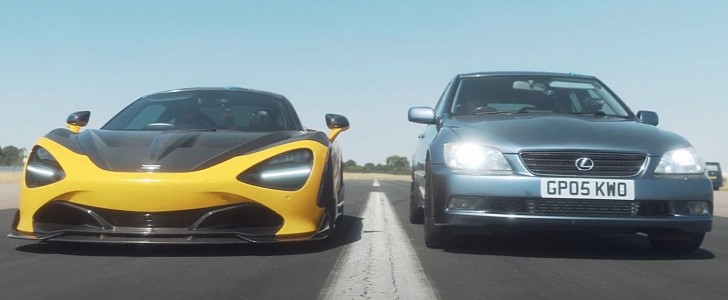There's more to going fast than having hundreds and hundreds of horsepower. You have to look at the aerodynamics, weight, gearbox, tires, suspension, and of course, the driver as well. There's a reason why supercars usually cost over $100,000, even if they're not brand new. Your old-school Japanese sports car might be exciting to drive, but chances are that it's never going to be as fast.
Sure, we've seen cases where tuned Skylines or Supras would take on older Ferraris and gap them during a rolling race. But chances are that the situation would be different when going around a race track. So even if your tuned sports car is packing 800-hp, that doesn't mean you're automatically going to be faster than a McLaren 720S. As mentioned before, there are plenty of factors to consider. Today's battle has a Lexus IS 300 with a 2JZ engine trying to compete against the 720S. The race was organized by Officially Gassed and revealed on their YouTube channel on August 28th.
Even though it packs more power, at least on paper, it's also heavier. Even though it's not running the standard gearbox anymore, it's still not quite on par with the one in the 720S. And you have to consider aerodynamics, too: while the IS 300 is a rather bulky station wagon, the 720S looks fast even when standing still. The rolling race is the first challenge of the day. The Mclaren immediately lunges into the lead, and by the time both cars have crossed the finish line, the gap is quite significant.
With a twin-turbo, 4.0-liter V8 under the hood, the pickup on the supercar is instantaneous. And so the second run reveals the same outcome. At this point, it doesn't seem like the IS 300 can win anything today. Looking at the telemetry data, the 720S needed 5.006 seconds to get from 62 mph (100 kph) up to 124 mph (200 kph). The IS 300 was almost half a second slower, and perhaps an extra 200 hp would have taken care of that.
The standing quarter-mile (402 meters) ends in complete humiliation for the Japanese station wagon. With a poor launch for both runs, it needs 13.205 seconds to cross the finish line. Meanwhile, the 720S proves that it's a 10-second car right out of the factory, which supports the relatively steep asking price for one these days.
Even though it packs more power, at least on paper, it's also heavier. Even though it's not running the standard gearbox anymore, it's still not quite on par with the one in the 720S. And you have to consider aerodynamics, too: while the IS 300 is a rather bulky station wagon, the 720S looks fast even when standing still. The rolling race is the first challenge of the day. The Mclaren immediately lunges into the lead, and by the time both cars have crossed the finish line, the gap is quite significant.
With a twin-turbo, 4.0-liter V8 under the hood, the pickup on the supercar is instantaneous. And so the second run reveals the same outcome. At this point, it doesn't seem like the IS 300 can win anything today. Looking at the telemetry data, the 720S needed 5.006 seconds to get from 62 mph (100 kph) up to 124 mph (200 kph). The IS 300 was almost half a second slower, and perhaps an extra 200 hp would have taken care of that.
The standing quarter-mile (402 meters) ends in complete humiliation for the Japanese station wagon. With a poor launch for both runs, it needs 13.205 seconds to cross the finish line. Meanwhile, the 720S proves that it's a 10-second car right out of the factory, which supports the relatively steep asking price for one these days.









